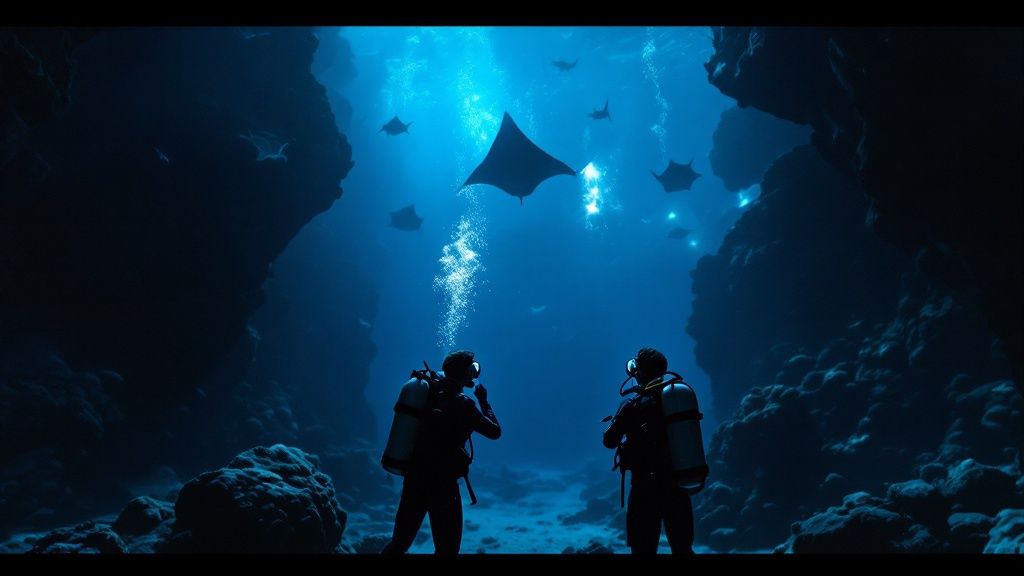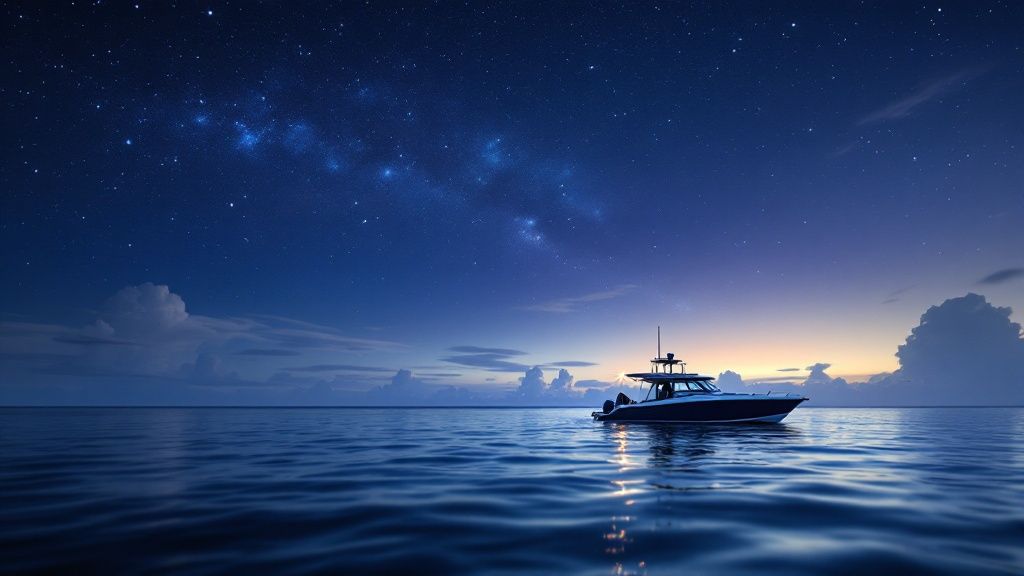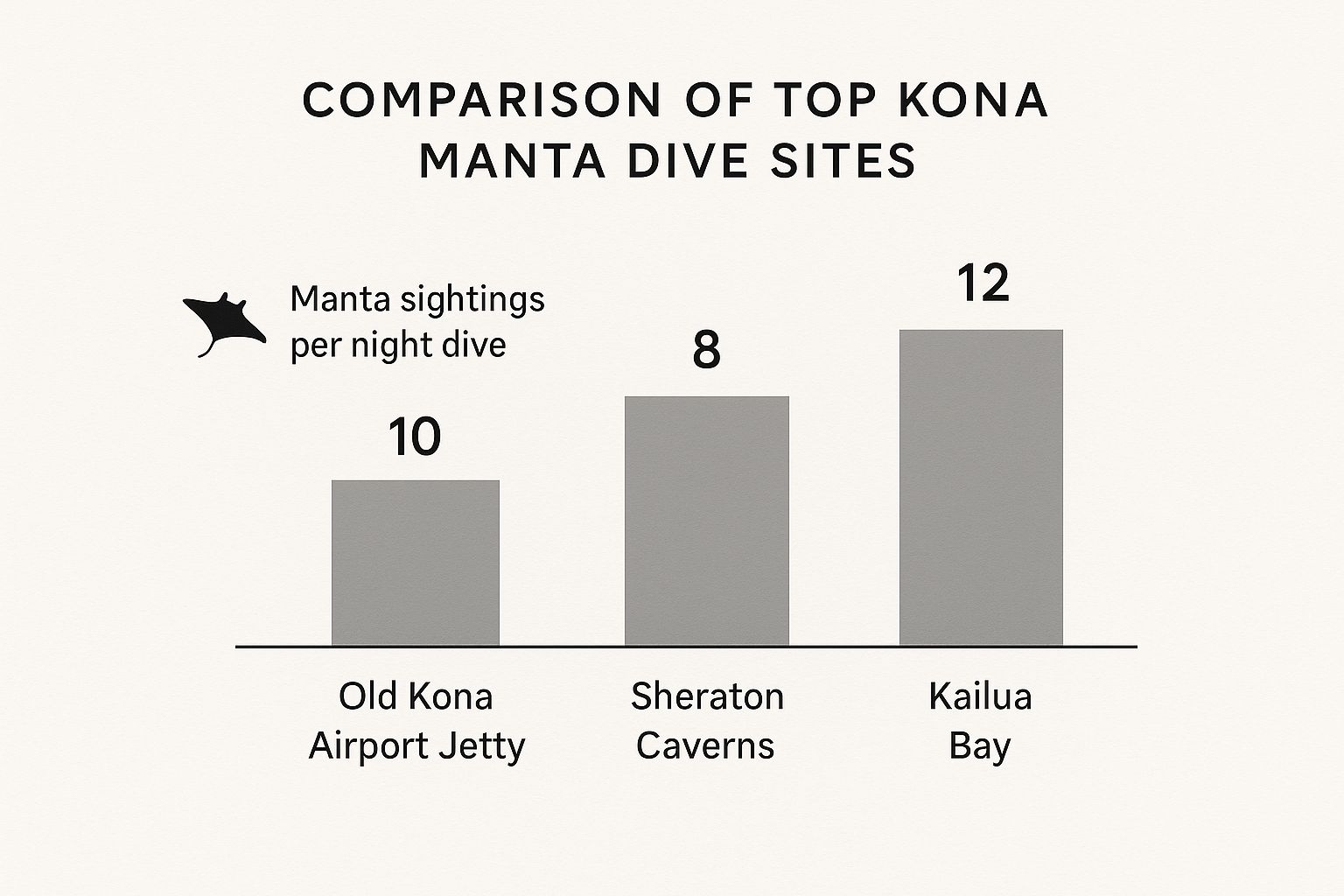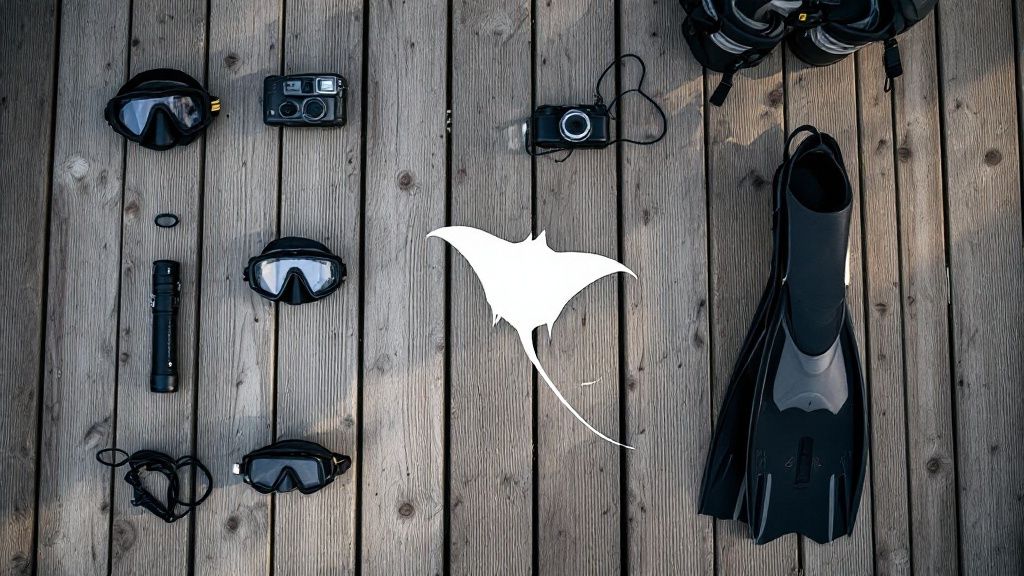Why Kona Dominates The Global Manta Diving Scene

When divers talk about the best places in the world for manta ray encounters, Kona, Hawaii, consistently tops the list. This isn't by chance; Kona's status as a premier manta destination comes from a special mix of natural wonders and strong conservation work. The island's volcanic past has sculpted an underwater world that's simply perfect for these amazing creatures.
The Perfect Recipe: Kona's Unique Underwater Environment
So, what makes Kona's underwater setting so special? It largely comes down to the ancient lava flows that have shaped the seabed. These volcanic formations aren't just for show; they create natural channels and protected bays that manta rays love.
Add to this the steady ocean currents that deliver a constant supply of nutrient-rich water. This fuels abundant plankton blooms, which happen to be the main course on a manta ray's menu. It's like a dependable nightly feast that keeps the mantas coming back for more.
This reliable food source, along with consistently warm and stable water temperatures throughout the year, means Kona’s manta rays tend to stick around. They don't need to travel far for meals, which makes their appearances very predictable.
This high level of predictability is a major draw for divers, making a manta dive kona experience one of the most reliable ways to see these gentle giants up close. If you're curious about this unique adventure, you can learn more about why a Kona manta ray dive is a must-do.
A Sanctuary And A Living Laboratory
Years of respectful human interaction and dedicated protective efforts have turned Kona's waters into a genuine sanctuary for manta rays. Researchers have identified over 450 individual manta rays in the area, each with unique spot patterns on their bellies, like an underwater fingerprint.
This flourishing population speaks volumes about the success of local conservation programs working hand-in-hand with the favorable natural environment. It's a clear sign that when we protect these creatures, they can truly thrive.
The combination of Kona's special underwater landscape and the reliable presence of manta rays makes it a hotspot for both divers and scientists. The area is often called a living laboratory, offering amazing opportunities to study manta behavior, their social lives, and how they reproduce.
This research provides valuable information that helps with manta ray conservation worldwide. You can explore further details on manta ray research efforts. This focus on understanding them means that every dive in Kona not only creates unforgettable memories but also helps protect these wonderful animals for the future.
Your Real Chances Of Manta Encounters In Kona Waters

If you're planning a manta dive kona adventure, it's completely natural to wonder about your actual chances of witnessing these incredible animals. The good news is that Kona is globally recognized for some of the most reliable manta ray sightings. This isn't just a marketing claim; it's supported by many years of careful observation and detailed dive logs.
Understanding Kona's High Success Rates
The statistics for manta encounters in Kona are notably high. For instance, experienced local dive operators often share reports of successful sightings on the vast majority of their excursions. Manta ray sightings in Kona show remarkable consistency, with some local dive businesses reporting encounters on 85-90% of dives. This impressive success rate is largely thanks to a resident population of over 450 identified individuals that regularly visit the area's feeding sites. You can Find more detailed statistics here.
This remarkable consistency changes a manta dive kona from a hopeful wish into a highly probable, awe-inspiring experience. The predictable nature of their appearance is a primary reason Kona stands out as a premier destination worldwide.
Factors That Boost Your Encounter Odds
Several key elements contribute to these high encounter rates. The presence of plankton blooms, the main food source for manta rays, is a significant attraction, especially at night when dive lights draw these microorganisms closer. Local operators are adept at tracking manta movements and understanding their feeding patterns, which allows them to predict the best diving times with considerable accuracy.
Additionally, certain environmental conditions can influence the presence and behavior of manta rays:
- Moon phases: The lunar cycle can affect plankton density and, consequently, manta ray activity.
- Seasonal variations: While mantas are present throughout the year, some periods might see slight changes in their numbers or preferred feeding locations.
- Optimal dive timing: Night dives are particularly renowned, as the lights used by divers attract a concentrated feast for the mantas.
Understanding these patterns is key. You might be interested in exploring: What Is Best Time Of Year To See Manta Rays In Kona? This knowledge helps operators consistently deliver those magical underwater moments, distinguishing Kona from other destinations where sightings can be much less predictable. By choosing experienced guides for your manta dive kona, you are benefiting from their deep understanding of these factors to maximize your chances of an unforgettable encounter.
Inside Kona's Legendary Manta Diving Locations

When you hear about unforgettable manta dive kona experiences, you might wonder, where do these amazing encounters actually happen? Along Kona's coast, there are several special spots that have earned a legendary status among divers. Each location offers a distinct glimpse into the lives of these majestic creatures, making it clear why divers flock here.
The Icons: Manta Village and Manta Heaven
Two prime locations often come up in conversations about Kona's manta dives: Manta Village and Manta Heaven. These are the go-to spots for many.
Manta Village, located near the Sheraton Kona Resort at Keauhou Bay (and sometimes called Sheraton Caverns), holds the title of the original manta ray night dive site. It's known for generally calm waters and consistent manta sightings, making it a great choice for divers with different levels of experience.
A bit further north, close to the Kona International Airport, you'll find Manta Heaven. This spot is also recognized as Garden Eel Cove or the Old Kona Airport Jetty area. While famous for its night dives, it's a lively dive location during the day too. The conditions can be a little more unpredictable than Manta Village, but it frequently draws large groups of mantas eager for their nightly plankton meal.

The visual above gives a snapshot of average nightly manta sightings at some of Kona's top spots. It shows that Kailua Bay leads with an average of 12 mantas per night dive. Next up is the Old Kona Airport Jetty area with an average of 10 sightings, followed by Sheraton Caverns reporting 8. These numbers suggest that any of these sites offer a strong chance for a fantastic manta dive kona.
To help you choose the best spot for your adventure, here's a comparison of the key manta diving locations in Kona. This table outlines what you can expect at each site, from depth to the kind of manta behavior typically observed.
Kona Manta Diving Sites Comparison
Comprehensive comparison of major manta diving locations including depth, best times, experience level, and typical manta behavior
| Site Name | Depth Range | Best Time | Experience Level | Typical Manta Behavior |
|---|---|---|---|---|
| Manta Village (Sheraton Caverns) | Approx. 30-45 ft | Nightly | Beginner – Intermediate | Graceful feeding loops, close passes, attracted to lights. |
| Manta Heaven (Garden Eel Cove/Old Airport Jetty) | Approx. 35-50 ft | Nightly | Beginner – Intermediate | Acrobatic "barrel rolls" while feeding, often larger groups. |
| Kailua Bay | Approx. 30-40 ft | Nightly | Beginner – Intermediate | Consistent feeding, high sighting numbers, close approaches. |
As you can see, while all sites offer incredible nighttime encounters, there are subtle differences in depth and the general vibe. Both Manta Village and Manta Heaven are well-established and cater to a range of divers, with Kailua Bay boasting impressive sighting numbers for your manta dive kona.
Exploring Beyond The Famous Sites
While Manta Village and Manta Heaven are certainly the headliners, seasoned local divers might point you towards other locations for a slightly different kind of experience. One such area is further up the Kohala Coast, near Kawaihae Harbor, where manta encounters are also possible.
The main draw for these alternative spots is usually fewer people in the water. However, this can sometimes mean that manta sightings might not be as guaranteed or frequent as at the more famous locations. It's a trade-off that could appeal to divers looking for a quieter, more off-the-beaten-path manta dive kona adventure.
Understanding Site Dynamics for Your Manta Dive Kona
No matter which location you pick for your manta dive kona, a few key environmental elements always shape the encounter. The underwater topography, a result of ancient volcanic flows, is vital. It creates natural nooks and crannies where plankton, the mantas' primary food source, tends to gather. This concentration of plankton is what determines the mantas' favorite dining spots.
Lighting is another critical factor, particularly for night dives. Dive operators strategically place powerful lights to draw in plankton, essentially setting up a dinner table for the mantas. The flow of currents also plays a part, influencing where plankton drifts and how the mantas behave.
Manta rays are present in Kona's waters all year. However, water clarity and surface conditions can change with the seasons, with the summer months generally bringing calmer seas. To get the best view, divers are usually settled on the seabed, looking up at the show. Snorkelers, on the other hand, stay at the surface, watching the mantas glide and feed within the light beams from above.
Selecting Your Perfect Kona Manta Dive Experience
Picking the ideal Kona manta dive tour can make the difference between a pleasant outing and a truly remarkable memory. Many companies offer these trips, and each provides a slightly different experience, so a bit of guidance can assist you in finding the tour that best suits your expectations.
Decoding Tour Types for Your Manta Dive Kona
Kona's most famous manta encounters occur after dark, offering different ways to see these magnificent creatures. Night dives are designed for certified scuba divers. You'll descend to the seabed, typically around 30-50 feet deep, and observe as mantas swim above, attracted to light beams while feeding. This provides an up-close and personal view.
If you're not scuba certified or simply wish to remain near the top, manta ray night snorkeling presents a wonderful alternative. Snorkelers usually grip a specially designed float that has lights to lure plankton, which in turn attracts mantas to the surface. Certain companies also run dedicated photography trips for those aiming to get amazing underwater shots. For an example of what a top-tier night dive involves, you can explore The Manta Ray Night Dive of Kona with Kona Honu Divers.
Key Questions to Ask Potential Manta Dive Operators
Prior to committing to a Kona manta dive, it's smart to have some important questions ready. Trustworthy operators will gladly provide clear answers.
- What are the established safety protocols, and what is the ratio of guides to guests? (Look for smaller groups, ideally 10-15 guests per guide).
- How does the company promote ethical manta interactions and support conservation efforts?
- What level of experience do the guides possess?
- What happens if no mantas are seen during the tour? (Many provide a "manta guarantee" for a return trip).
- What kind of equipment is supplied, and what is its maintenance schedule?
- What are the boat's dimensions and the maximum number of guests allowed on a single tour?
Posing these questions will help you assess an operator's dedication to safety, manta well-being, and providing a quality customer experience.
Spotting Quality and Avoiding Tourist Traps
Given how popular Kona manta dive tours have become, recognizing the signs of a high-quality operation is important. Seek out companies that place a strong emphasis on manta conservation and follow guidelines for responsible viewing. This often involves detailed pre-dive briefings about how to observe the mantas without disturbing them.
Boats in good condition and top-notch rental equipment are also positive signs. On the other hand, be cautious of certain red flags: operators guaranteeing manta sightings (remember, they are wild creatures), regularly running trips with too many people, or using high-pressure sales tactics. It's worth noting that on very active evenings, popular locations can see over 290 individuals in the water, which makes choosing your operator carefully even more essential for an enjoyable time.
Practical Considerations for Your Booking
The number of people on your tour can greatly affect your Kona manta dive experience. Generally, smaller groups mean more individualized attention from guides and less potential disruption for the mantas. Standard tours typically cost between $100 and $150, while premium or more specialized excursions might be priced from $150 to $250, or even higher.
When it comes to booking, reserving your spot ahead of time is a good idea, particularly if you're traveling during busy tourist periods, because well-regarded operators can sell out. Think about planning your manta dive for an earlier part of your visit to Kona. This gives you some flexibility to rebook if bad weather cancels your first attempt, or if the company has a "manta guarantee" for those infrequent times when mantas don't appear. Always make sure to review the operator's policy on cancellations.
The Cutting-Edge Science Behind Kona's Manta Research
Kona isn't just a top destination for a manta dive kona; it also serves as an important natural lab for marine scientists. Because manta rays are regularly found here, researchers get a special window into the lives of these gentle creatures, helping to solve their underwater secrets. This special environment makes it possible to conduct long-term research that can't be done in many other places.
Unlocking Manta Mysteries: Key Research Techniques
Scientists employ several important methods to learn about Kona's mantas:
- Photo Identification: Just like human fingerprints, the unique spot patterns on a manta's belly help identify individual animals. Researchers have identified over 450 manta rays in the local area this way, which helps track their populations and how loyal they are to specific sites.
- Satellite Tagging: By attaching temporary tags, scientists can uncover remarkable migration patterns. These tags show that mantas sometimes travel thousands of miles and also reveal their deep-diving habits.
- Behavioral Analysis: Through careful observation and video recordings, researchers work to understand the complex ways mantas interact. This provides clues about their social hierarchies and their impressive intelligence.
The information gathered through this research leads to significant findings. For example, detailed records of manta sightings over the years are extremely useful. Between 2009 and 2014, underwater videographers at spots known as 'Manta Village' and 'Manta Heaven' kept careful records of individual mantas, noting their condition and compiling monthly sighting numbers. This information helps us better understand their behavior and how their populations are doing. You can Find more detailed statistics here.
Current studies are always adding to what we know about how mantas reproduce, what they eat, and their thinking abilities. These discoveries change how we see their importance in ocean environments and directly support crucial efforts to protect them.
Did you know that even your manta dive kona experience can help? Through citizen science initiatives, divers are invited to share their photos of mantas. These images contribute to the manta identification database, aiding researchers. If you're curious about how responsible tourism plays a part, check out Our Commitment to Eco-Friendly Diving Practices. This scientific work, supported by careful divers, is essential for safeguarding Kona's mantas, making sure these amazing animals are around for others to see in the future.
How Your Dive Supports Conservation And Local Communities

When you decide to experience a manta dive kona, it’s not just about the incredible underwater sights you're about to see. Your choice actively contributes to the well-being of the local Kona community and supports important conservation work. This understanding adds another layer of reward to witnessing these amazing creatures up close.
Powering Kona's Economy And Manta Protection
Responsible manta tourism significantly boosts Kona's economy. Annually, about 80,000 people participate in snorkel and dive tours to observe manta rays in Hawaiian waters, with Kona being a premier location for these encounters. This stream of visitors directly benefits numerous local businesses—from tour operators and dive shops to hotels and restaurants—channeling millions into the local economy. Moreover, a portion of this income is dedicated to essential manta ray research and conservation projects, creating a direct link between tourism and environmental care. You can learn more about the positive effects of manta tourism.
This places a significant responsibility on dive operators. They aim to provide unforgettable encounters with these gentle giants while also advocating for their long-term safety and the preservation of their marine environment.
Tangible Impacts: From Research To Reef Cleanups
The financial contributions from your manta dive kona directly fund a range of effective conservation programs. These initiatives are crucial for the continued health of Kona's manta ray population and the broader marine ecosystem they call home.
Some key areas supported include:
- Manta Ray Identification Databases: These databases, often enhanced by information shared by divers like yourself (citizen science), are fundamental for tracking individual mantas, understanding population trends, and monitoring their health.
- Plastic Pollution Reduction Programs: Efforts to reduce marine debris and plastic pollution help protect mantas from entanglement and ingestion, keeping their feeding areas safe.
- Marine Research Scholarships: Tourism revenue can help sponsor the education of future marine biologists and conservationists who will dedicate their careers to studying and protecting these animals.
- Community Education Programs: These programs inform both local residents and visitors about the importance of manta ray conservation, helping to ensure that these awe-inspiring underwater experiences can be enjoyed by future generations.
Through these interconnected efforts, every participant in a manta dive kona becomes part of a larger movement that values and actively protects these wonderful ocean animals.
Proven Strategies For Epic Manta Encounters
Turning a regular manta dive in Kona into a truly breathtaking encounter comes down to a few key approaches. Experienced marine guides and underwater photographers have shared their best tips, which center on smart preparation, interacting respectfully, and paying close attention. This way, both you and the magnificent mantas have a wonderful and safe time.
Mastering Pre-Dive Essentials
Getting ready for your manta adventure starts well before you even get near the ocean. It's not just about packing the right equipment; having the correct mental approach is equally vital.
To make sure you're fully set for this incredible adventure, we've put together a detailed guide. This checklist walks you through everything from essential gear to important safety measures, helping you prepare for truly memorable encounters with these gentle giants.
Manta Diving Preparation Checklist
Complete pre-dive checklist covering equipment, skills, safety considerations, and etiquette for successful manta encounters
| Category | Essential Items/Actions | Skill Level | Notes |
|---|---|---|---|
| Equipment | Well-fitting mask, snorkel, fins, appropriate wetsuit (3mm-5mm recommended for Kona) | All | Test gear beforehand. Divers: ensure BCD, regulators, and dive computer are functioning perfectly. |
| Lighting | Reliable primary dive light (especially for night dives) | Divers | Always check your battery life; carrying a backup light is a smart move. |
| Mental Prep | Review manta interaction guidelines, practice staying calm | All | Deep, slow breathing can significantly help reduce anxiety and improve your air consumption underwater. |
| Briefing | Pay close attention to your guide’s instructions | All | Don't hesitate to ask questions if anything is unclear before you enter the water. |
Going through this checklist carefully ensures you’ve covered all the important bases before your dive. This preparation is key to a smoother, safer, and ultimately more rewarding experience watching the mantas.
Your state of mind is incredibly important. Staying calm, particularly when mantas are nearby, leads to much better interactions because these creatures are very aware of sudden or nervous movements. To get a real sense of how amazing these dives are and see these tips in action, check out What It's Like to Go on the Manta Ray Dive in Kona, Hawaii.
Underwater Tactics for Optimal Viewing
When you're in the water, where you are and how you act will shape your entire experience. Divers usually settle on a sandy area, often forming a semi-circle with their group, and point their lights up to draw in plankton, which mantas feed on. Snorkelers typically stay on the surface, holding onto a float that has lights pointing down into the water.
For divers looking to make the most of their time underwater, good breathing habits are essential. Slow, deep inhalations and exhalations help you save air and also keep you relaxed, which means you can watch the mantas for longer and more steadily. The main idea here is passive observation; allow the mantas to approach you. Never chase them or make quick movements, as this can frighten these peaceful animals.
Capturing the Magic and Understanding Manta Behavior
If you're hoping to photograph the stunning manta dive in Kona, a couple of specific techniques will help. A wide-angle lens usually gives the best results. Most importantly, avoid using flash photography aimed directly at the mantas, as this can bother them. It's better to use the existing light provided by the dive site's illumination.
Watch for signs that indicate a feeding frenzy is underway. You'll often see mantas doing elegant barrel rolls or gliding in swooping patterns as they filter plankton that has gathered near the lights. A noticeable increase in manta activity and more mantas appearing near the light source are definite clues.
Safety and Seasonal Insights
Following safety rules is vital for protecting both the divers and the remarkable marine creatures. Always pay attention to your guide and be mindful of what's around you, including other divers and the mantas. Never touch the reef or the mantas; even an accidental touch can damage the delicate mucus layer that protects them.
Kona's mantas can be seen throughout the year, and sighting success rates are frequently above 90%. However, there are some differences depending on the season. The summer months, from June to August, typically bring calmer waters and great visibility. No matter if you're a beginner snorkeler or an experienced diver, the most important rule is to respect the mantas and their habitat. This thoughtful conduct makes sure your manta dive in Kona is an amazing experience for everyone.
Are you excited to try out these strategies for your own incredible manta encounter? Secure your unforgettable manta dive in Kona adventure with Kona Honu Divers today and witness the enchantment for yourself! Plan Your Dive with Kona Honu Divers.
